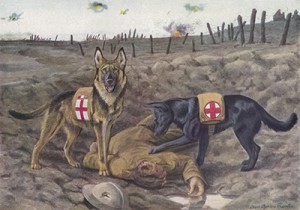The Belgian Laekenois

“The Laekenois, which entered Miscellaneous in 2011, has become our 196th recognized breed and the latest addition to the ever-expanding Herding Group.”
By Amy Fernandez
Belgium, despite its scanty geographic share of the continent, has produced a remarkable bounty of purebreds. We know all about the Brussels Griffon, but the rest of them have truly had to fight for their purebred identity. Even that’s a bit odd when you consider that Belgium gave us Fédération Cynologique International aka FCI. Well anyway, there was a new addition to the Herding Group on July 1. The Laekenois joins its Belgian cousins the Malinois, Tervuren and Belgian Sheepdog as another one of those low-key breeds that get the job without fanfare.
Similar to the rest of the clan, these breeds evolved from regionally cultivated strains of all-purpose farm dogs that existed throughout northern Europe. Square, sturdy, strong and agile, it looks every inch a dog that means business. Well balanced and sturdy, with moderate bone, it’s an athlete through and through, geared to do a job and do it well. Its clean cut, chiseled head, almond eyes and all-knowing expression let you know that this is the genuine article.
Obviously, there’s much more than coat and color differentiating these breeds. But those are the signifiers that became the basis of AKC classifications. In that respect, the Belgian Laekenois ranges in color from fawn to red, sometimes with grayish tones and dark accents–usually on the tail and the face–which further accentuate its keen expression. Like the others, the Laekenois is smart, responsive, and clearly demonstrates a Type-A working drive. Staunch, devoted, and determined, the traits that ensured its crossover success from farm to battlefield are reliably ingrained. Temperamentally, they are loyal, cautious, and vigilant. In other words, they love their people, but this is a serious worker. Respect that.
The Laekenois, as its name implies, heralds from the Laeken region of Belgium where it was used for centuries as a livestock guardian and all-purpose farm dog. National efforts to separate and classify Belgian Working breeds began with the formation in 1891 of the Club Chien de Berger Belge. At that point, several of them had strong grassroots support throughout Holland and France as well.

Ironically, as Northern Europe’s agricultural economy gave way to industrialization, WWI immediately provided a new high-profile career for Belgian Working breeds. Their innate talents for military service also brought them to the attention of Americans. Herbert Hoover was possibly the most famous fan back then.
Like its cousins, the Laekenois is built to work and its protective nature ensured its popularity as a go-to breed for police and military service. No one was even dreaming of a repeat when in 1927 National Geographic wrote, “During the World War he proved one of the most dependable and valuable of dogs on the battlefield.” It’s important to note that these breeds were then experiencing an incredibly rocky time over here.
Traditionally, Belgium’s Working breeds haven’t had a smooth ride within the AKC structure. Over the years they have been accepted, ejected, combined and separated repeatedly, making it difficult to keep track of their status in the AKC hierarchy. This quote from the 1949 Modern Dog Encyclopedia gives you some idea. “The predominance of the long coated black type has caused most people to think that all Belgian Shepherds are black.” Davis did add that the “the short-coated fawn type was very popular in earlier times.” Yeah well, its popularity was somewhat hindered by the fact that it didn’t officially exist. A decade later, AKC formally separated the Malinous, Tervuren, and Belgian Sheepdog. By then, it was too little too late.
The German Shepherd’s popularity had long ago outstripped the Belgian breeds, which made for an untenable situation when AKC decided they belonged under the same heading in the studbook. As expected, getting those totally unrelated breeds separated was hard work. Also, it was just the tip of the iceberg.
That fight commenced with the epic battle to get them separated from the German Shepherd. The board really objected to the Shepherd/Sheepdog situation as many meeting minutes reveal and the German Shepherd-–although the most popular breed at that time–was stubbornly classified as German Sheep Dog until 1918. The revision was a short victory because a year later AKC again changed its name to Shepherd Dog. Keep in mind that even nationwide popularity and big money supporters couldn’t get them to budge until 1931. Anyway, Belgian breeds had no chance in this corporate environment.
The Belgian Sheepdog, then called the Groenendael was at first more popular, which was no surprise since the other two languished in their combined limbo. Its favored treatment was most likely because it was black and therefore easily distinguished from the others. The Malinois and the Tervuren were eventually separated in 1959, but even then, eight distinct breeds were acknowledged to exist in Belgium. Didn’t matter. AKC can never be accused of impulsive decisions.
So, the Laekenois, which entered Miscellaneous in 2011, has become our 196th recognized breed and the latest addition to the ever-expanding Herding Group. It waited long enough so don’t forget to cheer next time you’re watching the group.

Short URL: https://caninechronicle.com/?p=187409
Comments are closed











